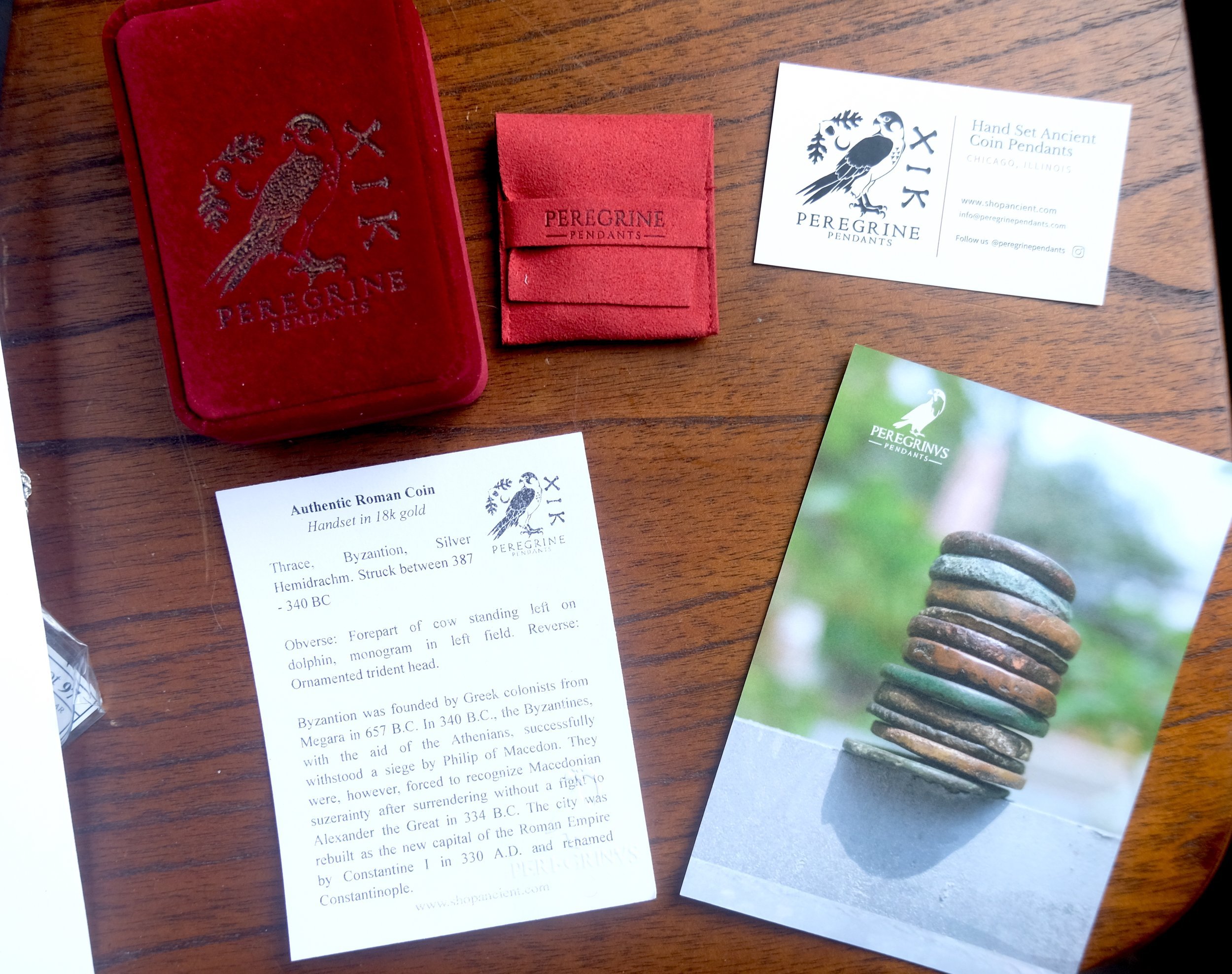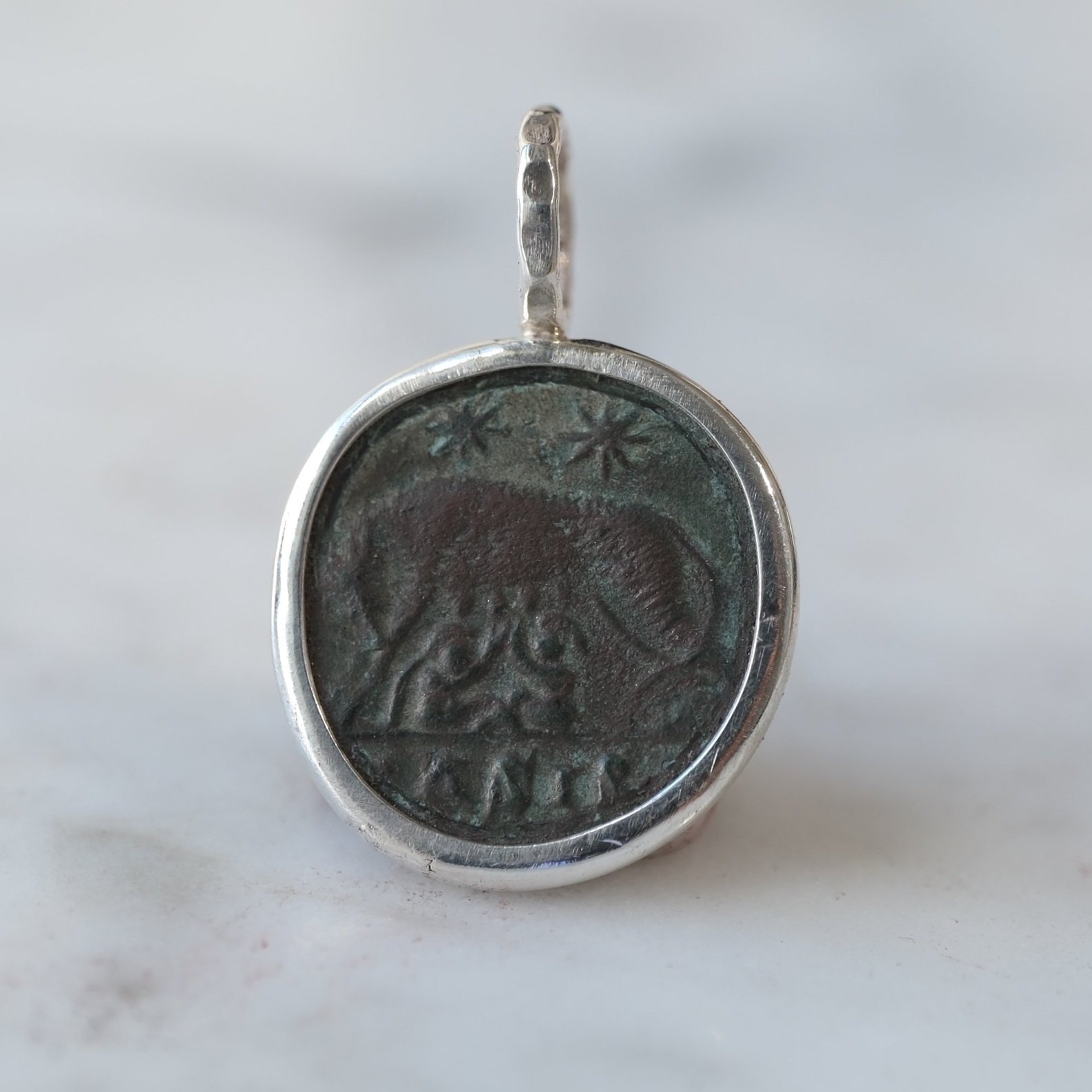 Image 1 of 4
Image 1 of 4

 Image 2 of 4
Image 2 of 4

 Image 3 of 4
Image 3 of 4

 Image 4 of 4
Image 4 of 4





Civil War - 1862 Two Cent set in silver
To appreciate its size, the relief of the coin and the shape of the bail, see the picture showing the coin next to a US quarter. The coin was first set in a gold bezel, which was then hammered over the edge of both sides. This was then sanded and polished. This pendant is built to last.
-- Coin information:
The two-cent piece was produced by the Mint of the United States for circulation from 1864 to 1872 and for collectors in 1873. Designed by James B. Longacre, there were decreasing mintages each year, as other minor coins such as the nickel proved more popular. It was abolished by the Mint Act of 1873. The economic turmoil of the American Civil War caused government-issued coins, even the non-silver Indian Head cent, to vanish from circulation, hoarded by the public. One means of filling this gap was private token issues, often made of bronze. The cent at that time was struck of a copper-nickel alloy, the same diameter as the later Lincoln cent, but somewhat thicker. The piece was difficult for the Philadelphia Mint to strike, and Mint officials, as well as the annual Assay Commission, recommended the coin's replacement. Despite opposition from those wishing to keep the metal nickel in the coinage, led by Pennsylvania Congressman Thaddeus Stevens, Congress passed the Coinage Act of 1864, authorizing bronze cents and two-cent pieces. Although initially popular in the absence of other federal coinage, the two-cent piece's place in circulation was usurped by other base-metal coins which Congress subsequently authorized, the three-cent piece and the nickel. It was abolished in 1873; large quantities were redeemed by the government and melted. Nevertheless, two-cent pieces remain relatively inexpensive by the standards of 19th-century American coinage.
****
Why buy from us? I see a lot of pre-made bezels, that are made for modern coins passing as "handmade" jewelry. Each of our coins is carefully handset in a custom made bezel which takes time and skill.Import fees, duties, customs fees etc. charged by the buyer's country will be the sole responsibility of the buyer. It is impossible for us to know what these fees are so please direct your questions on these matters to your country's customs department. We cannot refund postage on orders that are returned because of customs issues, including refusal to pay customs on the part of the buyer.
To appreciate its size, the relief of the coin and the shape of the bail, see the picture showing the coin next to a US quarter. The coin was first set in a gold bezel, which was then hammered over the edge of both sides. This was then sanded and polished. This pendant is built to last.
-- Coin information:
The two-cent piece was produced by the Mint of the United States for circulation from 1864 to 1872 and for collectors in 1873. Designed by James B. Longacre, there were decreasing mintages each year, as other minor coins such as the nickel proved more popular. It was abolished by the Mint Act of 1873. The economic turmoil of the American Civil War caused government-issued coins, even the non-silver Indian Head cent, to vanish from circulation, hoarded by the public. One means of filling this gap was private token issues, often made of bronze. The cent at that time was struck of a copper-nickel alloy, the same diameter as the later Lincoln cent, but somewhat thicker. The piece was difficult for the Philadelphia Mint to strike, and Mint officials, as well as the annual Assay Commission, recommended the coin's replacement. Despite opposition from those wishing to keep the metal nickel in the coinage, led by Pennsylvania Congressman Thaddeus Stevens, Congress passed the Coinage Act of 1864, authorizing bronze cents and two-cent pieces. Although initially popular in the absence of other federal coinage, the two-cent piece's place in circulation was usurped by other base-metal coins which Congress subsequently authorized, the three-cent piece and the nickel. It was abolished in 1873; large quantities were redeemed by the government and melted. Nevertheless, two-cent pieces remain relatively inexpensive by the standards of 19th-century American coinage.
****
Why buy from us? I see a lot of pre-made bezels, that are made for modern coins passing as "handmade" jewelry. Each of our coins is carefully handset in a custom made bezel which takes time and skill.Import fees, duties, customs fees etc. charged by the buyer's country will be the sole responsibility of the buyer. It is impossible for us to know what these fees are so please direct your questions on these matters to your country's customs department. We cannot refund postage on orders that are returned because of customs issues, including refusal to pay customs on the part of the buyer.
To appreciate its size, the relief of the coin and the shape of the bail, see the picture showing the coin next to a US quarter. The coin was first set in a gold bezel, which was then hammered over the edge of both sides. This was then sanded and polished. This pendant is built to last.
-- Coin information:
The two-cent piece was produced by the Mint of the United States for circulation from 1864 to 1872 and for collectors in 1873. Designed by James B. Longacre, there were decreasing mintages each year, as other minor coins such as the nickel proved more popular. It was abolished by the Mint Act of 1873. The economic turmoil of the American Civil War caused government-issued coins, even the non-silver Indian Head cent, to vanish from circulation, hoarded by the public. One means of filling this gap was private token issues, often made of bronze. The cent at that time was struck of a copper-nickel alloy, the same diameter as the later Lincoln cent, but somewhat thicker. The piece was difficult for the Philadelphia Mint to strike, and Mint officials, as well as the annual Assay Commission, recommended the coin's replacement. Despite opposition from those wishing to keep the metal nickel in the coinage, led by Pennsylvania Congressman Thaddeus Stevens, Congress passed the Coinage Act of 1864, authorizing bronze cents and two-cent pieces. Although initially popular in the absence of other federal coinage, the two-cent piece's place in circulation was usurped by other base-metal coins which Congress subsequently authorized, the three-cent piece and the nickel. It was abolished in 1873; large quantities were redeemed by the government and melted. Nevertheless, two-cent pieces remain relatively inexpensive by the standards of 19th-century American coinage.
****
Why buy from us? I see a lot of pre-made bezels, that are made for modern coins passing as "handmade" jewelry. Each of our coins is carefully handset in a custom made bezel which takes time and skill.Import fees, duties, customs fees etc. charged by the buyer's country will be the sole responsibility of the buyer. It is impossible for us to know what these fees are so please direct your questions on these matters to your country's customs department. We cannot refund postage on orders that are returned because of customs issues, including refusal to pay customs on the part of the buyer.

















